This was published 2 years ago
Reader, I bought them: The Aussies helping reel in literature’s ‘great white whales’
If state libraries reflect their communities, why are their historic collections still so stacked towards male writers? Armed with a love of women and literature, two Melbourne philanthropists are seeking to redress that imbalance.
By Melissa Fyfe
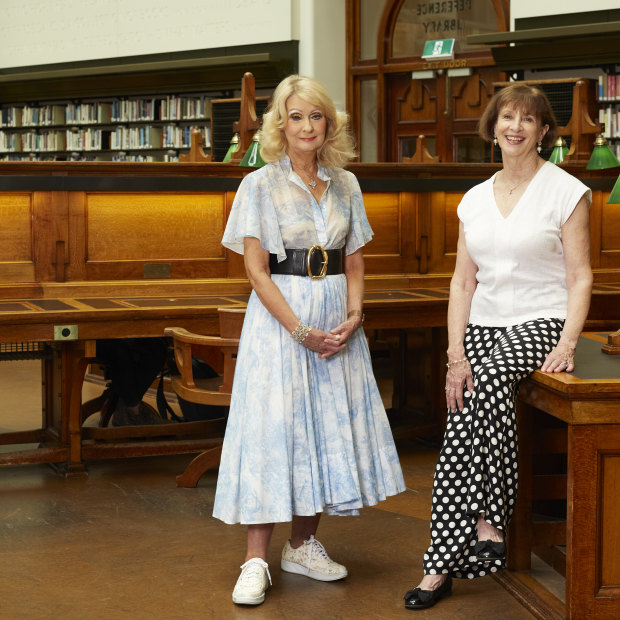
Philanthropists Krystyna Campbell-Pretty, left, and Helen Sykes, are key supporters of the State Library Victoria’s Women Writers Fund.Credit: Mia Mala McDonald
Krystyna Campbell-Pretty opens the enormous front door to her mansion and suddenly I feel underdressed. This wasn’t supposed to happen. I’d read that Campbell-Pretty, one of Melbourne’s most intriguing philanthropists, believes that good manners and being well-dressed is about “courtesy and consideration” for others. So I’d buffed my boots and donned my best suit (well, my only one). But she looks like a 1950s starlet and I look like a door-knocking Jehovah’s Witness. Her gold-painted eyelids gleam in the afternoon light; her blonde hair is perfect and her dress is a cornflower blue Christian Dior number. I look it up later but only find its accessories (a matching visor will set you back $870, so you get the idea). The only concession Campbell-Pretty makes to the inescapable fact that it’s an exceptionally ordinary Melbourne weekday, is her flat, white sneakers. “Bunions are genetic,” she explains later.
I’m actually here to talk about the remarkable collection of rare books that Campbell-Pretty, 70, and fellow philanthropist Helen Sykes, 66, are helping the State Library Victoria purchase. But as we enter the foyer of her heritage-listed, 1855-built home in East Melbourne, it’s impossible to escape the topic of fashion. In front of us stands a handful of gowned mannequins, like a headless posse of stiff ladies gathering for a ball. She rattles off the designers – Toni Maticevski, Stella McCartney, Oscar de la Renta – but it’s like she’s speaking another language. Disdain flits across her face when I inquire whether these might become part of the National Gallery of Victoria’s collection (Campbell-Pretty, one of the world’s most significant fashion collectors, has gifted the gallery 350 garments since 2015). “Oh no, these are not worthy of the NGV,” she says, tut-tutting my sartorial ignorance. “They are all ready-to-wear. So not particularly special, but, you know, they look good.”
We embark on a tour of the Italianate boom-style mansion, which was owned by nuns for most of the last century. When Campbell-Pretty and her late husband Harold removed some of the nuns’ interior-design work (orange shag-pile carpets! vinyl wood panelling!) many of the original features – the stained glass, parquetry floors, tiles – were remarkably intact. The couple once used the mansion as the corporate headquarters for their management consultancy, Campbell Pretty Research & Strategy, which boasted clients such as IBM, Compaq and Ford, and was sold in 2002. (The “cash cow” of the company was the market research arm, says Campbell-Pretty, who was a social worker before marrying Harold.)
The couple once funded bus trips into the NGV for children from regional areas, but since Harold’s unexpected death in 2014, Campbell-Pretty has taken things to a whole new level with her gifts to the NGV and the State Library. Sometimes she visits her husband’s grave to tell him how she’s spending their fortune. She’s a big believer in giving your money away while you are alive and wishes they’d given more away sooner.
“Because you never know what’s going to happen. I tell people that all the time and they don’t listen,” says Campbell-Pretty, who has two adult children and two grandchildren.
We pass a small room containing a rack full of identical-looking fawn puffer jackets and head out the back, where a modern extension looks on to a pool. Campbell-Pretty turns off federal parliament’s Question Time on the television. Two dolls are propped on the couch – a mini Barack and Michelle Obama – gifts from friends recently returned from the US. “It’s a right-wing country. We should just understand that and we wouldn’t get so upset,” Campbell-Pretty says, reflecting on the current state of American politics.
We return to the historic wing and sit on two gold-trimmed chairs facing a bay window. Outside, a rough downpour lays siege to the forecourt pond. Campbell-Pretty explains that it was a special handbag that led her to underwriting the Women Writers Fund, which was set up in 2021 to fill holes in the State Library’s rare book collection. At a London auction in 2018, Campbell-Pretty came across a silk purse called a “slave bag”. Dated around 1826, the dainty piece bore a picture of a West Indies slave woman and her child, and was made by middle-class British women in local, anti-slavery ladies’ societies. They distributed them to the aristocracy as a form of political statement. The bag captivated Campbell-Pretty, who bought it for about $15,000 and gave it to the NGV.
The bag piqued her interest in women’s activism and her focus then jumped a few decades to the guerilla-like campaign of the British suffragettes, who won women universal voting rights in 1928 (South Australia, in a world-first, had beaten them to it in 1894). She became one of Australia’s foremost collectors and experts in suffragette materials and donated her collection – hunger-strike medals, board games, sashes, pins – to the NGV. But, looking for a more appropriate home for her suffragette newspaper collection spanning 1907-1908, she approached the library in late 2020.
As a collection, these items begin to create a parallel history, one often devalued and forgotten in the mists of time.
The library took the newspapers and Campbell-Pretty asked if they had a women’s fund for buying up neglected areas of women’s writing, history and achievement. They were working on it, they said. In mid-2021, the library came back to Campbell-Pretty with the idea of a Women Writers Fund and then went on to secure the support of another Melbourne philanthropist, Helen Sykes.
The fund has now purchased 104 items, including what the library considers its “great white whale”: a first-edition Jane Austen (Northanger Abbey and Persuasion in a set). They’ve also picked up a first edition of Virginia Woolf’s gender-shifting tale Orlando: A Biography; the first illustrated edition of Mary Shelley’s gothic classic, still with its original title: Frankenstein; Or, The Modern Prometheus; and a 1497 medieval guide to famous women written by Italian monk Giacomo Filippo Foresti. In October, the library secured $1 million from a trust set up in the name of Helen Macpherson Smith, a philanthropically-minded heiress who left £275,000 in 1951 to be spent on Victorian charities. The trust helped fund the Austen purchase and will support an annual marquee oration.
As a collection, these items begin to create a parallel history, one often devalued and forgotten in the mists of time: the story of women’s achievement, their lives and roles in history. This is the story that drives Campbell-Pretty’s philanthropy.
“It’s important for our children, for our daughters and for our sons, to know that it’s not just that women got the vote and suddenly were able to go to school and work. They’ve always been able to write, to paint, to do music, to do many things … but they were not acknowledged for their work. That news was kept down.”
The State Library Victoria’s “father”, Sir Redmond Barry, wasn’t your average colonial establishment figure. Famously known as the judge who sentenced Ned Kelly to death, Barry flouted the social conventions of mid-1800s Melbourne by never marrying Louisa Barrow, the beloved mother of his four children. He also allowed the public into his house at night to read his private collection of books and journals.
When he founded what was then known as the Melbourne Public Library in 1854, Barry wanted it to be a “people’s university” and modelled it on London’s South Kensington Museum, now the V&A: membership was not required, all you needed to do was just walk in and start reading. “That model of being open to everybody was entirely radical and it’s still not the model of major libraries around the world,” says Anna Welch, the State Library’s Principal Librarian, History of the Book and Arts.
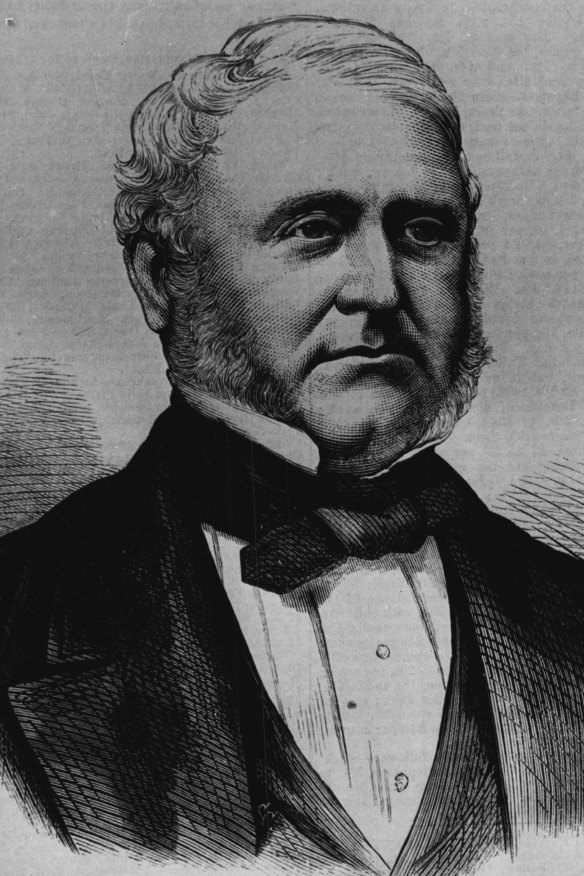
Sir Redmond Barry established what eventually became the State Library Victoria in 1854. At the time, his library model of being open to everyone was “entirely radical”.
But being a working person’s library in those early decades meant it was a place predominantly for men. And the book collection – focused on educational improvement and professional skills – did not include literature. This meant that books that other libraries may have collected at the time – such as first editions of Jane Austen or George Eliot (the pen name of Mary Ann Evans) – were missed by the library, and now they’re all frightfully expensive.
But Barry’s collecting proclivities weren’t the only problem. There were bigger structural impediments to women’s writing, including their lack of access to higher education and their all-consuming domestic duties. In her 1929 book, A Room of One’s Own – a first edition now acquired by the fund – Virginia Woolf recounts setting off on a dismal London day to the British Museum with basic questions about how women lived across history, only to find an avalanche of books on women by men, but none on women by women.
There was also the problem of censorship: in her recent book Femina, medieval historian Janina Ramirez writes about the destruction of female-authored books, especially from the Reformation onwards, when libraries were scoured for controversial texts and marked “witchcraft”, “heresy”, “Catholic” and “femina” (written by women).
Sometimes female authors and figures of note were left out of male-written history for decades. The works of Mary Wollstonecraft, for example, the women’s rights campaigner, philosopher and French Revolution historian, were shunned for a century because she’d had an illegitimate child, suffered depression and had some relationships without getting married, a penalty her male peers would not have faced (the fund has purchased a 1794 first edition of Wollstonecraft’s book on the French Revolution, but the one coveted most by Sykes and Campbell-Pretty is her hugely influential 1792 A Vindication of the Rights of Woman: With Strictures on Political and Moral Subjects).
Then there’s women such as Émilie du Châtelet, a French mathematician, philosopher and polymath, whose 1756 translation of Newton’s basic laws of physics is still used today. History remembers her more for being Voltaire’s mistress than for her remarkable intellectual achievements (the fund has purchased several of her works).
Writings by women of colour suffered the double discrimination of race and gender, evidenced by the library’s lack of first editions of American novelist Toni Morrison, despite her winning the 1993 Nobel Prize in Literature (the fund has purchased five of Morrison’s first editions, including the Pulitzer-prize-winning Beloved. It also purchased a first edition of Efuru, the first novel by Nigerian author Flora Nwapa, who some consider to be the mother of modern African literature.)
These female-shaped gaps in the library’s collection meant that Welch and her retired boss Des Cowley often struggled putting together the World of the Book exhibition, an annual showcase for the rare-book collection (of the library’s 2 million books, more than 100,000 are classified as rare). “A really good example is women in science. We weren’t able to tell a kind of well-rounded curatorial story about the development of different aspects of science,” says Welch, who admits that Redmond Barry, a stickler for the latest edition of everything, would probably “be a bit horrified at the notion of rare books”.
I’m walking towards the library’s vaulting, domed reading room when I see Anna Welch steering a heavy-set trolley towards me. On top are half a dozen books – each a gem of the Women Writers Fund – and we pop into a side room to inspect them. We sit at a long table and admire the spiralling black ribbon of iron staircase in the corner. Welch points out that stiletto-heeled librarians once raced up those steps to fetch books. “I’ve never heard of any deaths, so I think everyone survived,” she says.
Welch carefully places one volume of the 1818 first-edition matching set of Northanger Abbey and Persuasion on a special calico pillow. “Austen is the kind of iconic example of the sort of book that hasn’t been collected here,” says Welch. “And we never thought we’d be able to get this, because they go for such extraordinary prices these days.” The library does not disclose the financial value of rare books, but first editions of these Austens go for between $30,000 and $50,000 depending on their condition. (The State Library of NSW purchased an 1816 first edition of Emma for an undisclosed amount in 2017.)
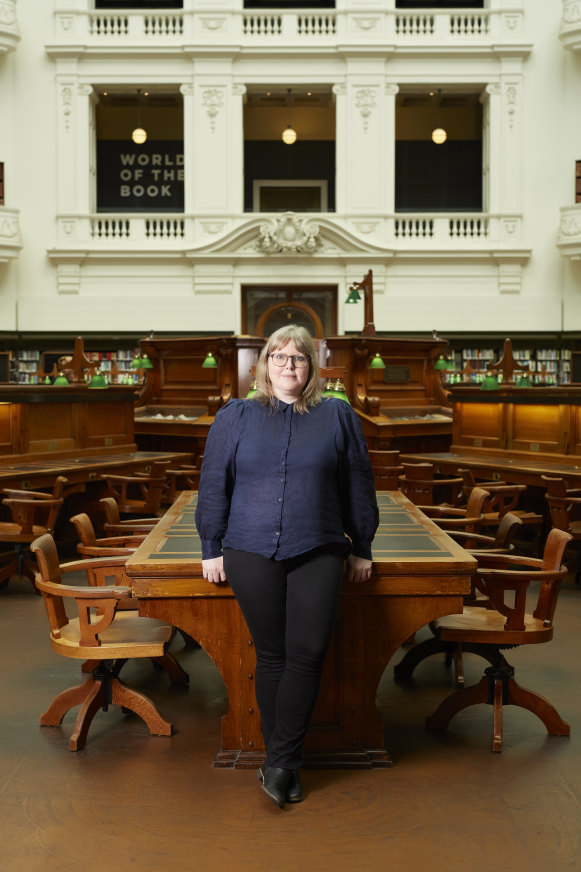
State Library Victoria’s Anna Welch: “Austen is the kind of iconic example of the sort of book that hasn’t been collected here.”Credit: Mia Mala McDonald
My question for Welch is – why the need for rare copies? Why first editions? You can now get Austen editions in every imaginable form: digital, audio, leatherbound and flimsy paperback. “You can buy Austen adaptations with zombies,” notes Welch, “and anything else you want.” But, she says, there are often significant bibliographic and textual differences between editions, which make first editions important. “I think there is also real value in being able to preserve the first issue of a book or idea as it comes into the world, to be able to appreciate it in a way that maybe it wasn’t appreciated when it was first published.”
Welch lets me turn the pages and I can see what she’s talking about: it’s a little thrilling to think this is how someone more than 200 years ago first received the last two books of one of the greatest English authors. Published six months after Austen’s untimely death at 41, the books have drab, blue-marbled covers and surprisingly large type, which traverses pages pocked with brown age spots called “foxing”, a process usually caused by iron fibres in the paper, or mould.
“I think there is real value in being able to preserve the first issue of a book or idea as it comes into the world.”
I open the page to the “Biographical Notice of the Author”, thought to be written by Austen’s brother Henry. Before these two books, the public did not know that Austen was the author of her prior novels Sense and Sensibility, Pride and Prejudice, Mansfield Park and Emma. But here is her brother pulling back the curtain on the identity of his genius sister while revealing the tragic fact that “the hand which guided that pen is now mouldering in the grave”.
“To anyone who’s interested in the history of English literature, this is a really important moment,” says Welch. “And this physical artefact helps you understand that history.”
Welch settles another book on the pillow: De Claris Selectisque Mulieribus, the Italian monk Foresti’s 525-year-old catalogue of famous historical and mythological women. Published in 1497, it features some of the earliest woodcut portraits of real women and is an “incunable”, the technical term for a book produced in the printing press’s first 50 years.
The text, in a black and ornate medieval font, is in Latin, which, impressively, Welch can read (turns out a PhD in medieval manuscripts is quite handy). It contains biographies of 172 women of good and bad moral character, a sort of guidebook for how medieval noblewomen should behave.
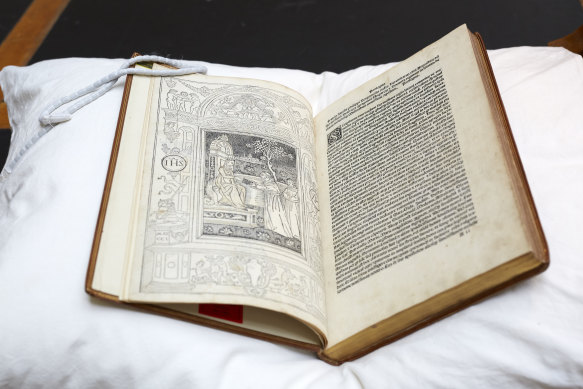
The 1497 De Claris Selectisque Mulieribus.Credit: Mia Mala McDonald
Says Welch: “Basically the message is: ‘Don’t be like Eve, do be like the Virgin Mary.’ ” Not all the books are so rarefied: the fund also purchased several books by Mrs J (Mary Anne) Sadlier, a sort of 1800s-era chick-lit author read by thousands of women across the Irish Catholic diaspora, including in Australia. Despite their popularity, the library didn’t own any copies.
Welch shows me the The Suffrage Cook Book: “One truth thoroughly mangled, one generous handful of injustice …” and, in a plastic slip, an extremely rare funeral pamphlet for the suffragette Emily Wilding Davison. Davison made international headlines when she walked in front of King George V’s racehorse clutching a “Votes for Women” scarf at the 1913 Derby. She died from her injuries four days later.
The pamphlet details the price paid for her activism – the hunger strikes, the force-feeding, being hosed down in Strangeways Prison – and the social ails she was fighting against: the lack of voting rights, poor support for widows, unsafe and badly paid work, the high infant death rate due to mothers’ “pitiable condition”, paedophilia and prostitution.
Then Welch lays down what looks like a children’s book: 2002: Childlife One Hundred Years From Now. Published in 1902, this brightly decorated science fiction mini-novel is about a girl called Polly and her life in 2002. Rather presciently, the author, American Laura Dayton Fessenden, speculated that people would be able to communicate with each other on screens. But she didn’t get everything right. She also predicted the election of a female president, universal vegetarianism and a perpetual peace beginning in 1980. “It is everything that we still aspire to and in many cases haven’t reached yet,” says Welch.
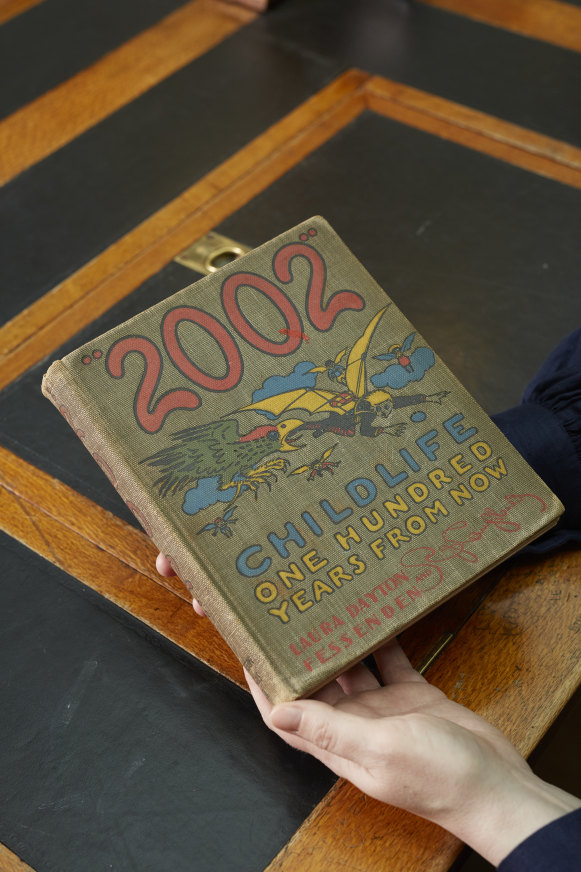
The book, 2002: Childlife One Hundred Years From Now, published in 1902, was rather prescient.Credit: Mia Mala McDonald
Rare-books seller Suzanna Beaupré appears on my screen and I’m momentarily disappointed. Surely a rare-book trader would be much older, with spectacles teetering on her nose and peering through mini-skyscrapers of dusty books. And a cat. Surely there would be a haughty cat ambling across the screen. But, alas, Beaupré appears simply with a white wall behind her, because it’s early over there in London right now and she’s at home.
Beaupré, 28, has worked as a cataloguer for the respected rare-books seller Peter Harrington for six years and was part of the team that produced its first catalogue dedicated to works by exceptional women in 2019. She has a master’s in early modern history from Cambridge University and specialises in the visual culture of heresy and witchcraft. Recently she acquired a 1670s magic book, which detailed spells against crows and the circumstances in which you might try putting a bat’s wing under your arm. Her delight is obvious. “That was quite a moment,” she says.
A sort of Indiana Jones of the book world, Beaupré hunts down forgotten and lost treasures (although mercifully fewer booby-trapped tunnels are involved). She sources her loot from local and international auctions, private collectors, book fairs and the public. “We constantly get phone calls from people saying: ‘I’ve just inherited this.’ Or ‘I just got up in my grandmother’s attic and I don’t know what to do with this.’ ”
Beaupré says there is a trend among institutions to address gender disparity in their collections, but the State Library Victoria’s earmarking of specific funds for this purpose marks its collecting as “significant”. She says one of the world’s stand-out female collections is Duke University’s Lisa Unger Baskin Collection, the largest trove of women’s history material previously held in private hands.
“It’s one of the most exciting emails you can get from an institution,” says Beaupré of inquiries like those from the State Library, with still no sign of a cat nearby. “I said, ‘I’m going to do everything I can to get you an Austen!’ I physically saw [the Northanger and Persuasion set] come in and I was like, ‘Wait! I need that for the State Library of Victoria! Hands off!’ ”
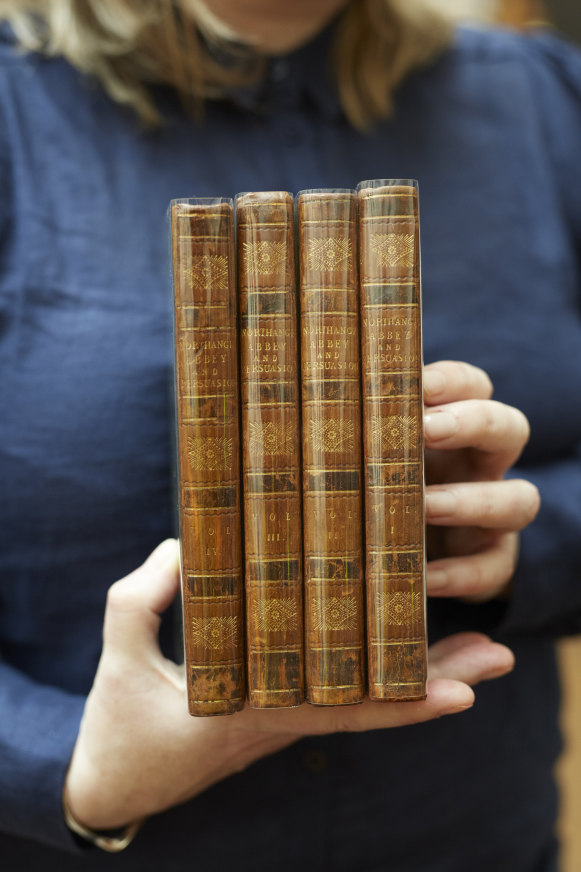
The 1818 first-edition Jane Austen matching set of Northanger Abbey and Persuasion.Credit: Mia Mala McDonald
The other philanthropist at the heart of the fund is a great deal more understated than Krystyna Campbell-Pretty. Helen Sykes lives in a lovely big house near Melbourne’s Royal Botanic Gardens with her husband, Carlton premiership-winning player and investment banker Mike Fitzpatrick. There are no mannequins nor gilded furniture, but lots of books: Sykes studied English literature and language at Oxford University, where she developed a love for libraries at its world-famous Bodleian Library and Radcliffe Camera. “Libraries are a real spiritual home for me.” She went on, briefly, to be a journalist, then a freelance book editor. She’s had a long involvement with Dementia Australia and supporting young sufferers of acquired brain injury.
Sykes is a big Virginia Woolf fan, and helped the fund purchase a first edition of Orlando: A Biography, the gender-bending tale of an apparently immortal noble Englishman who turns into a woman. Inspired by Woolf’s lover, the novelist and aristocrat Vita Sackville-West, it’s been called “the longest and most charming love letter in literature”.
“We all have male and female characteristics but society, over the years, has told us we need to tailor that according to our gender. Orlando is a really interesting exploration of both sides of a person’s personality and still very pertinent, 100 years later,” Sykes says. “When the opportunity came up to purchase it, I said, ‘Yeah, go for it!’ ” As she says this, her whole face sweeps into a grin.
“It’s important that young women can see that the goals they might want to achieve have been achieved by women 200 to 300 years ago.”
Sykes hopes people will feel a sense of identity and ownership about the fund and support it with their own donations. For her, the fund is about giving young women a sense of being part of a continuum of study and intellectual achievement. “It’s not only about the female literary figures, but the scientists, the mathematicians, the political thinkers: it’s important that young women can see that the goals they might want to achieve have been achieved by women 200 to 300 years ago.”
Back at the mansion, it’s becoming clear that Krystyna Campbell-Pretty is an addict. An auction addict. When I suggest this to her, she looks a little guilty and produces the most magical chuckle. “I think that’s true. But not for me, for public collections. If something’s been ignored and neglected, to me, it’s just wrong that that’s allowed to continue.”
She’s often up until the wee hours bidding on international auctions for the State Library and the NGV. And she succeeds, mostly, in keeping her head.
The one thing that she might lose her head about, she admits, would be if an early version of Christine de Pizan’s 1405 The Book of the City of Ladies came up for sale. In it, de Pizan, a French biographer, poet and proto-feminist, has Lady Reason demolish all the misogynistic arguments of her day through examples from history, myth or fable, or Bible excerpts (astute watchers of Netflix’s recent docudrama Blood, Sex & Royalty might have spotted Anne Boleyn thumbing a copy during her stay in the French court). Early copies are extremely rare.
In 2019, the first English translation of de Pizan’s military compilation The Boke of the Fayt of Armes and of Chyvalrye, printed in 1489, sold for £137,500 (about $240,000) at Sotheby’s. But for Campbell-Pretty, it is, along with Wollstonecraft’s Rights of Woman, a Holy Grail item. “If it came up for auction, all bets would be off. It’s whatever it takes in that case.”
To read more from Good Weekend magazine, visit our page at The Sydney Morning Herald, The Age and Brisbane Times.